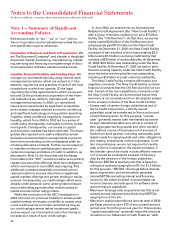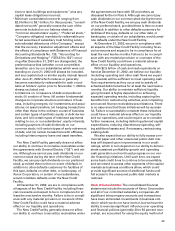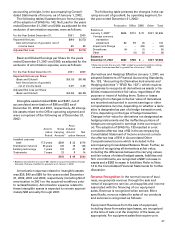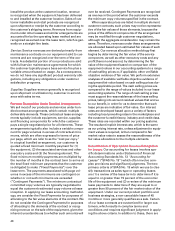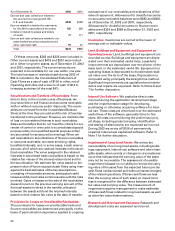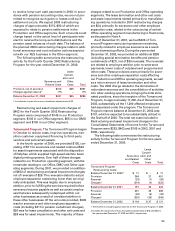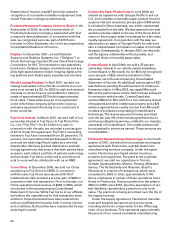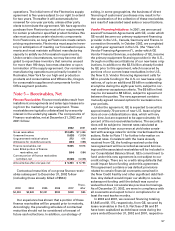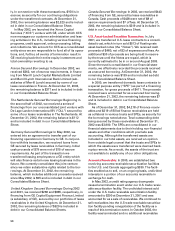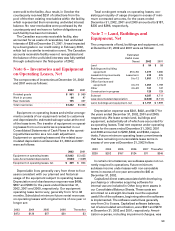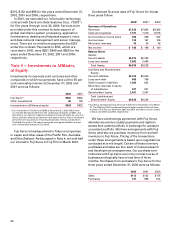Xerox 2002 Annual Report Download - page 52
Download and view the complete annual report
Please find page 52 of the 2002 Xerox annual report below. You can navigate through the pages in the report by either clicking on the pages listed below, or by using the keyword search tool below to find specific information within the annual report.
50
evaluations of our receivables and evaluations of the
risks of repayment. Allowances for doubtful accounts
on accounts receivable balances were $282 and $306,
as of December 31, 2002 and 2001, respectively.
Allowances for doubtful accounts on finance receiv-
ables were $324 and $368 at December 31, 2002 and
2001, respectively.
Inventories: Inventories are carried at the lower of
average cost or realizable values.
Land, Buildings and Equipment and Equipment on
Operating Leases: Land, buildings and equipment are
recorded at cost. Buildings and equipment are depre-
ciated over their estimated useful lives. Leasehold
improvements are depreciated over the shorter of the
lease term or the estimated useful life. Equipment on
operating leases is depreciated to its estimated resid-
ual value over the term of the lease. Depreciation is
computed using principally the straight-line method.
Significant improvements are capitalized and mainte-
nance and repairs are expensed. Refer to Notes 6 and
7 for further discussion.
Internal-Use Software: We capitalize direct costs
incurred during the application development stage
and the implementation stage for developing,
purchasing or otherwise acquiring software for inter-
nal use. These costs are amortized over the estimated
useful lives of the software, generally three to five
years. All costs incurred during the preliminary proj-
ect stage, including project scoping, identification
and testing of alternatives, are expensed as incurred.
During 2002 we wrote off $106 of permanently
impaired internal-use capitalized software. Refer to
Note 7 for further discussion.
Impairment of Long-Lived Assets: We review the
recoverability of our long-lived assets, including build-
ings, equipment, internal-use software and other intan-
gible assets, when events or changes in circumstances
occur that indicate that the carrying value of the asset
may not be recoverable. The assessment of possible
impairment is based on our ability to recover the carry-
ing value of the asset from the expected future pre-tax
cash flows (undiscounted and without interest charges)
of the related operations. If these cash flows are less
than the carrying value of such asset, an impairment
loss is recognized for the difference between estimated
fair value and carrying value. The measurement of
impairment requires management to make estimates
of these cash flows related to long-lived assets, as well
as other fair value determinations.
Research and Development Expenses: Research and
development costs are expensed as incurred.
As of December 31, 2002 2001
Escrow and cash collections related to
the secured borrowings with GE –
U.S. and Canada $349 $199
Escrow related to distribution payments
for the 2001 trust preferred securities 155 229
Collateral related to swaps and letters
of credit 77 111
Escrow and cash collections related to our
asset-backed security transactions and
other restricted cash 97 47
Total $678 $586
Of these amounts, $263 and $235 were included in
Other current assets and $415 and $351 were includ-
ed in Other long-term assets, as of December 31, 2002
and 2001, respectively. The current amounts are
expected to be available for our use within one year.
The total increase in restricted cash during 2002 of
$92 is included in the Consolidated Statement of
Cash Flows as a use of cash of $104 in other, net of
Operating Activities and a source of cash of $12 in
investing activities (of the total $41).
Securitizations and Transfers of Receivables: From
time to time, in the normal course of business, we
may securitize or sell finance and accounts receivable
with or without recourse and/or discounts. The receiv-
ables are removed from the Consolidated Balance
Sheet at the time they are sold and the risk of loss has
transferred to the purchaser. However, we maintain risk
of loss on our retained interest in such receivables.
Sales and transfers that do not meet the criteria for sur-
render of control or were sold to a consolidated special
purpose entity (non-qualified special purpose entity)
are accounted for as secured borrowings. When we
sell receivables in securitizations of finance receivables
or accounts receivable, we retain servicing rights,
beneficial interests, and, in some cases, a cash reserve
account, all of which are retained interests in the securi-
tized receivables. The value assigned to the retained
interests in securitized trade receivables is based on the
relative fair values of the interest retained and sold in
the securitization. We estimate fair value based on the
present value of future expected cash flows using man-
agement’s best estimates of the key assumptions,
consisting of receivable amounts, anticipated credit
losses and discount rates commensurate with the risks
involved. Gains or losses on the sale of the receivables
depend in part on the previous carrying amount of the
financial assets involved in the transfer, allocated
between the assets sold and the retained interests
based on their relative fair value at the date of transfer.
Provisions for Losses on Uncollectible Receivables:
The provisions for losses on uncollectible trade and
finance receivables are determined principally on the
basis of past collection experience applied to ongoing




